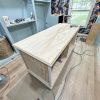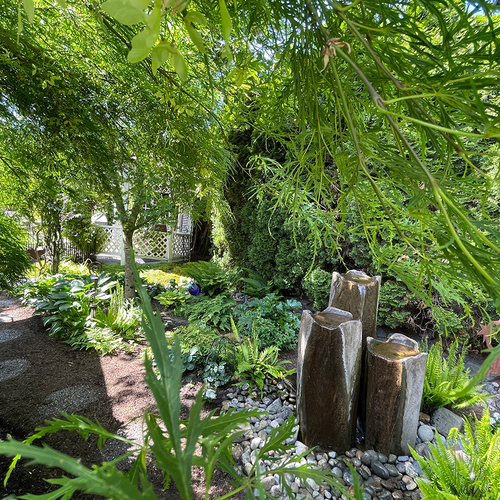
Hi GPODers!
Yesterday we got an update from Beth Tucker, a frequent contributor based in North Carolina (check that out here if you missed it: Irises and More). Today we’re on the opposite coast to visit another friend of the blog, Lila Johnson, in Mill Creek, Wash. (Zone 8b).
Hello, it’s me again. We are experiencing one of our first warm, sunny mornings here in Mill Creek, just North up I-5 from Seattle, so after I enjoyed my coffee on the patio, I wandered through our backyard and snapped some photos . . . mostly green foliage!
My husband and I, both in our early 80s, have planted mostly geraniums, impatiens, and pots full of a variety of summer annuals. So in spring, it’s the green tones that capture our attention, along with some of our trusty purple clematises, azaleas, and rhododendrons.
Our geraniums, purchased in early April, had to be put inside the garage every night due to the chilly temperatures. We couldn’t plant them until just after Mother’s Day. Even some of the daytime temperatures were below 45 degrees! They suffered a bit, but they are finally full of buds and awaiting sunny days like today!
We have been inundated with hungry rabbits the past four to five years, and although we use more than 25 wire cages and some interim plastic fencing in the early spring, they have forced us to make changes in what annuals we plant—no more zinnias, petunias, or marigolds. They eat our roses, low-growing Japanese maples, conifers, deer ferns (Struthiopteris spicant syn. Blechnum spicant, Zones 5–8), hostas, black mondo grass (Ophiopogon planiscapus ‘Nigrescens’, Zones 6–11), liatris (gay feather), and echinacea. So far, the rabbits have not developed a taste for impatiens or geraniums! We hope you enjoy our spring greens in the Pacific Northwest!
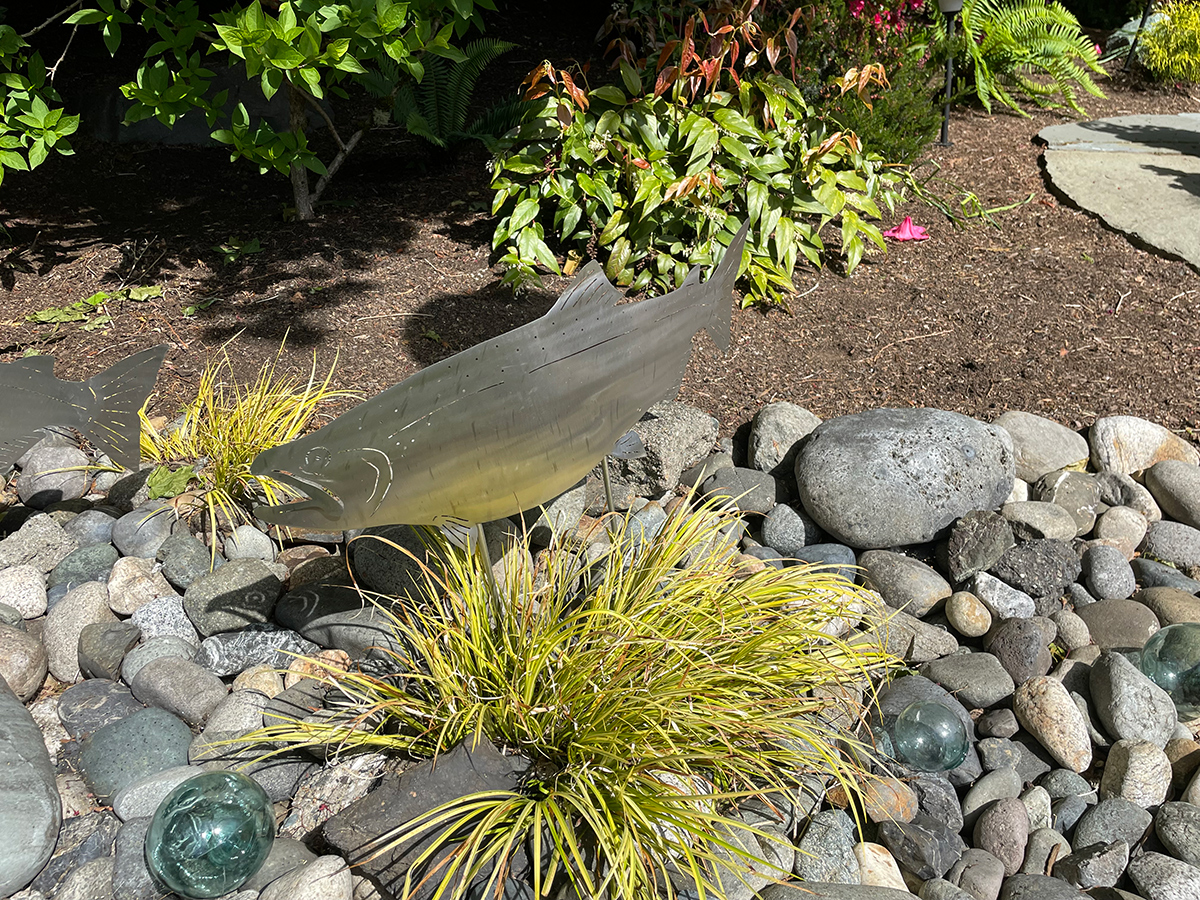 When the garden is still coming into color during spring, perfectly placed art can do some heavy lifting. These shiny silver salmon sculptures look marvelous swimming through Lila’s beds and are made even more spectacular by the chartreuse grasses that reflect on the salmon’s stomach.
When the garden is still coming into color during spring, perfectly placed art can do some heavy lifting. These shiny silver salmon sculptures look marvelous swimming through Lila’s beds and are made even more spectacular by the chartreuse grasses that reflect on the salmon’s stomach.
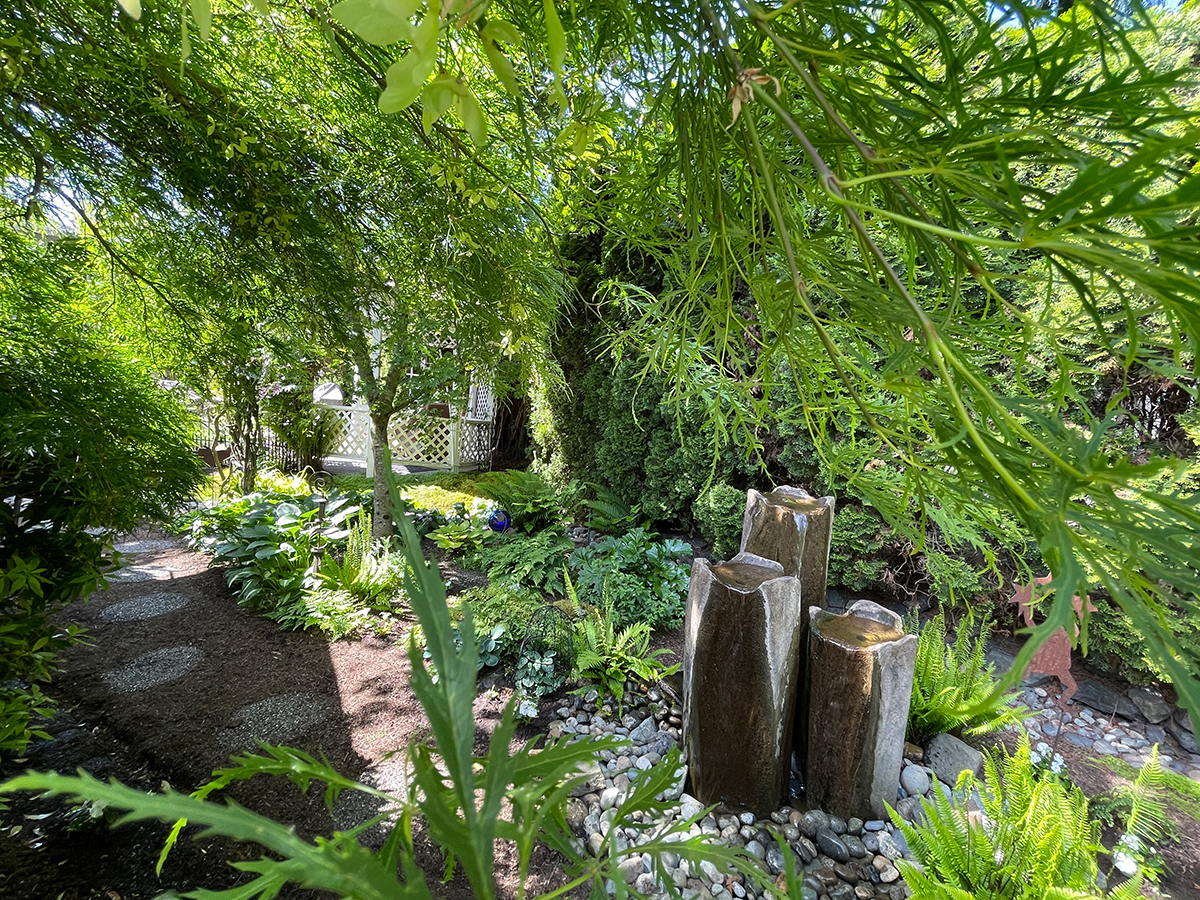 In the shady areas, I plant white impatiens, which are nestled in among the many deer ferns (Struthiopteris spicant syn. Blechnum spicant, Zones 5–8), sword ferns (Polystichum munitum, Zones 5–9), hostas, Jacob’s ladders (Polemonium reptans, Zones 4–8), and Himalayan maidenhair ferns (Adiantum venustum, Zones 5–8).
In the shady areas, I plant white impatiens, which are nestled in among the many deer ferns (Struthiopteris spicant syn. Blechnum spicant, Zones 5–8), sword ferns (Polystichum munitum, Zones 5–9), hostas, Jacob’s ladders (Polemonium reptans, Zones 4–8), and Himalayan maidenhair ferns (Adiantum venustum, Zones 5–8).
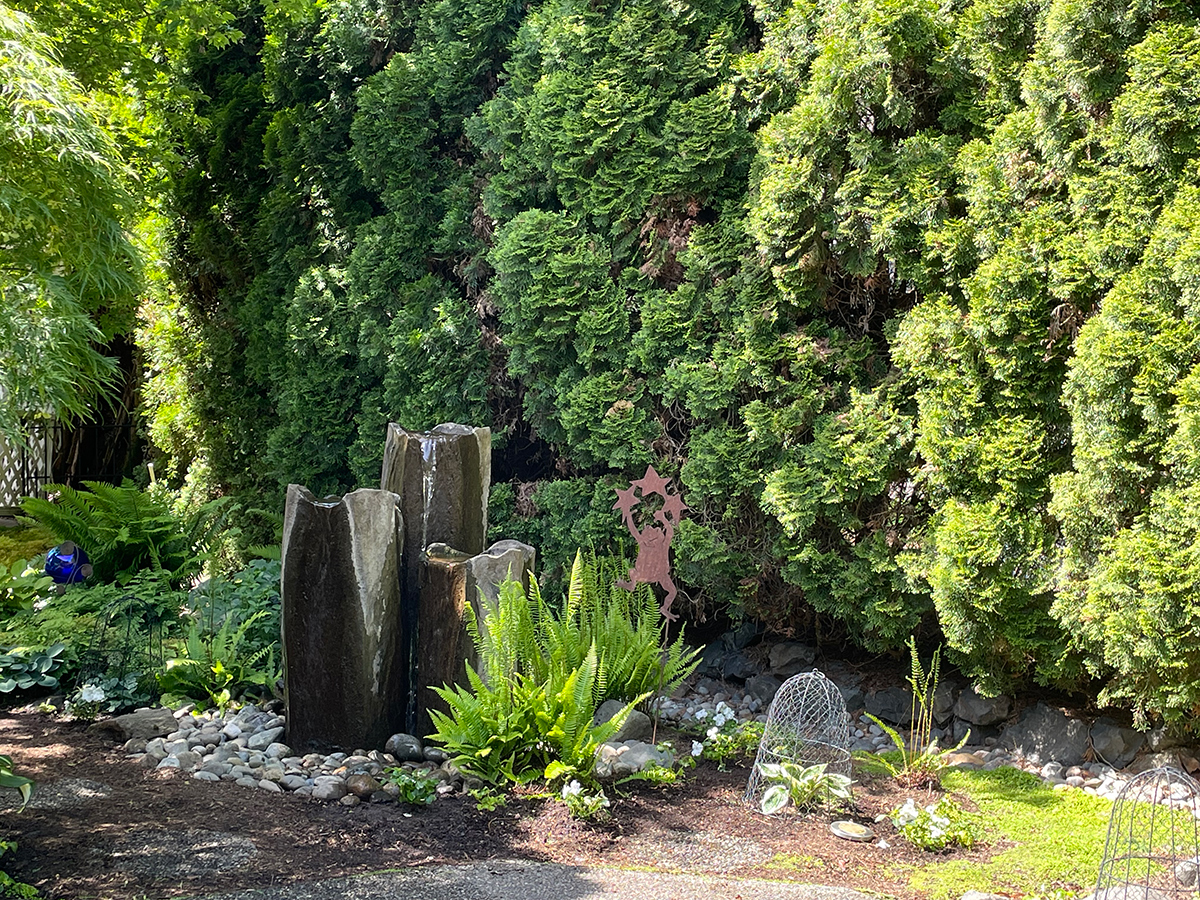 Another look at this shady spot and the gorgeous water feature; Lila’s spring plant palette is calm and soothing, and the sound of running water from these tall fountains adds to the tranquility.
Another look at this shady spot and the gorgeous water feature; Lila’s spring plant palette is calm and soothing, and the sound of running water from these tall fountains adds to the tranquility.
 When a plant pairing isn’t remarkable in color, textures and forms step up and show off. A small ladybug decoration is another touch of personality to make this vignette a little more fun.
When a plant pairing isn’t remarkable in color, textures and forms step up and show off. A small ladybug decoration is another touch of personality to make this vignette a little more fun.
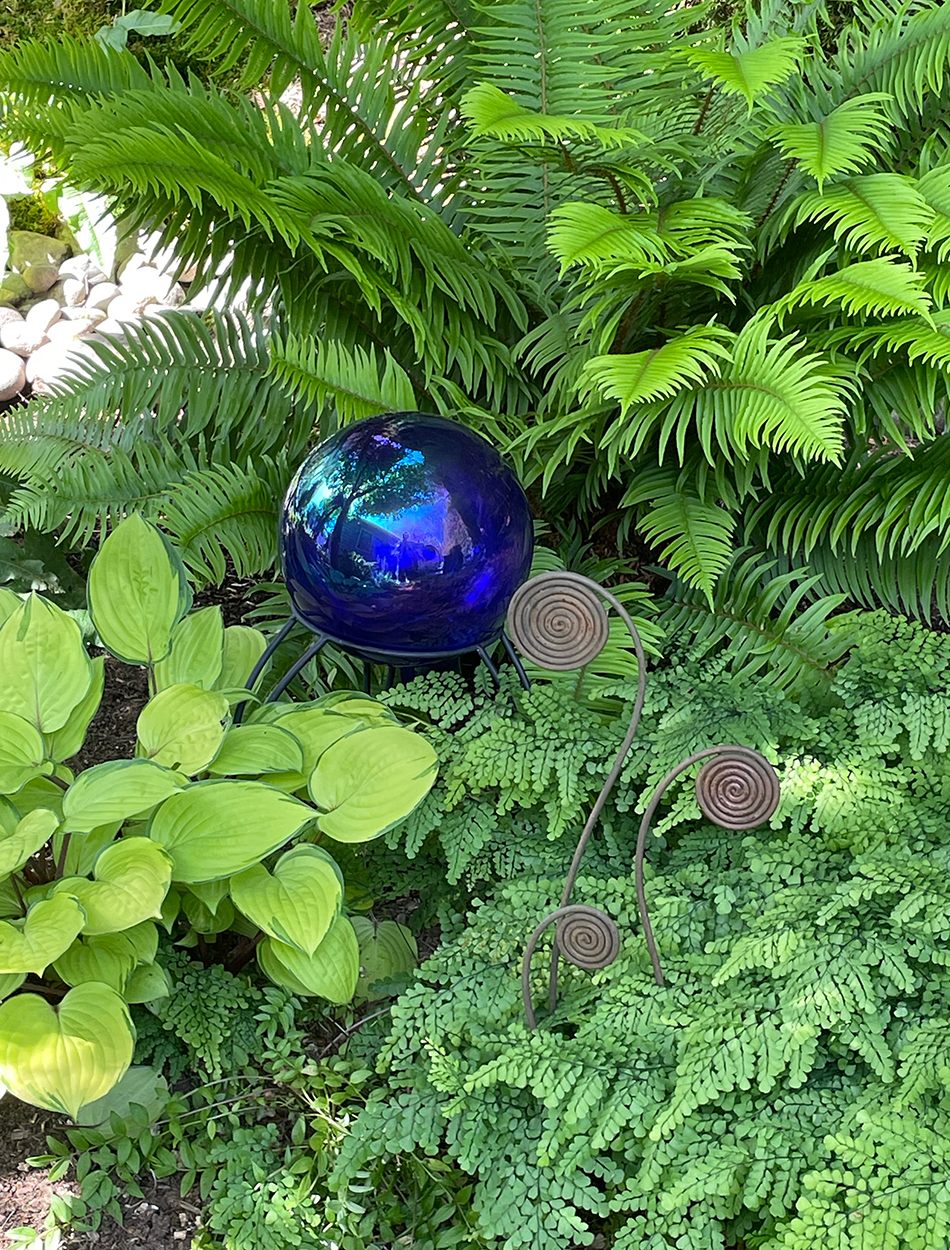 As Lila mentions above, she mixes several different ferns for interest in the shade. The distinctly different western sword and Himalayan maidenhair ferns pair wonderfully with a chartreuse hosta. A reflective blue garden orb adds a cool color.
As Lila mentions above, she mixes several different ferns for interest in the shade. The distinctly different western sword and Himalayan maidenhair ferns pair wonderfully with a chartreuse hosta. A reflective blue garden orb adds a cool color.
 Another perspective on a sensational sword fern
Another perspective on a sensational sword fern
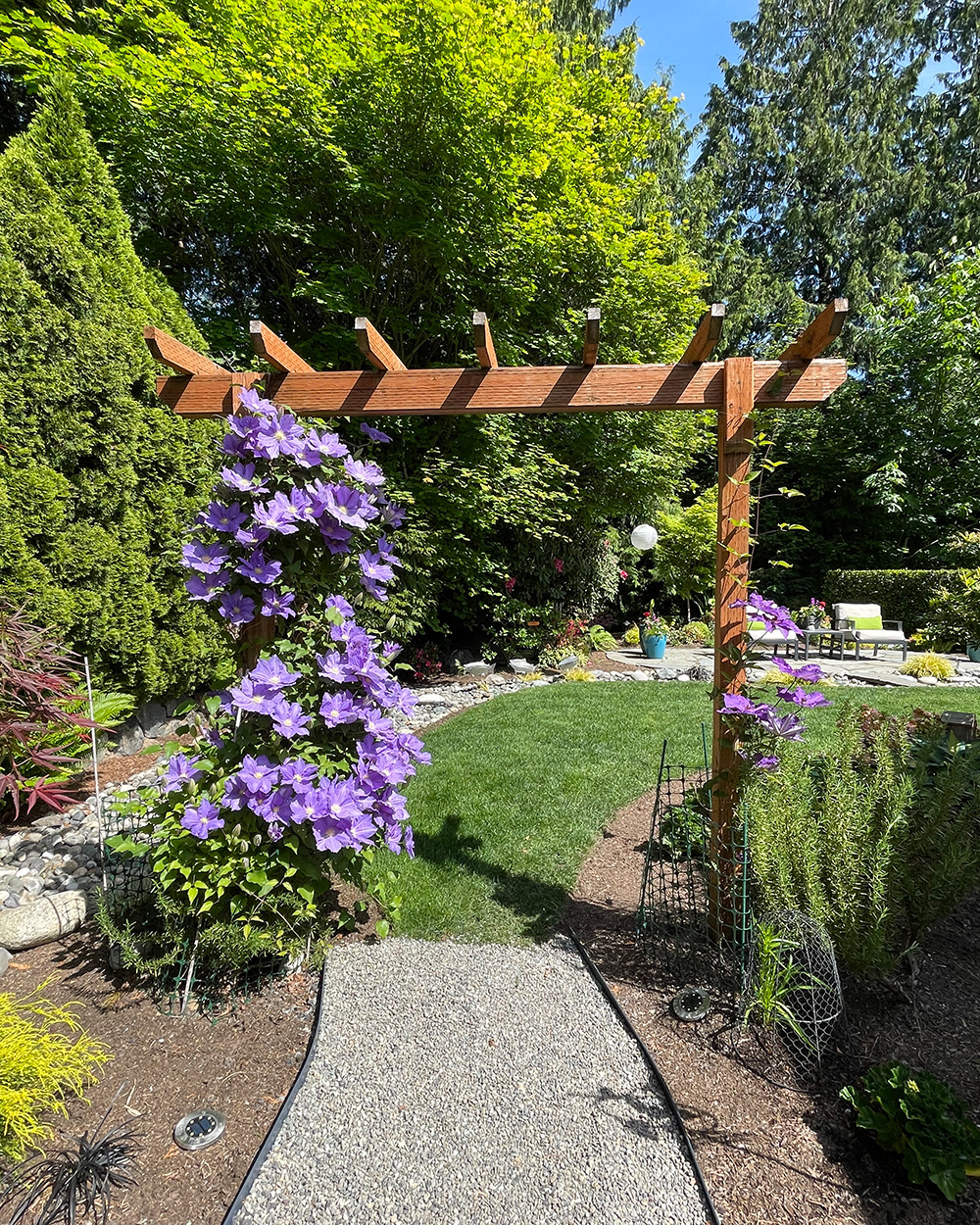 Not green, but PURPLE! It’s taken a few years, but we’ve finally got a thriving H. F. Young clematis (Clematis ‘H.F. Young’, Zones 4–9) established on the west side of our arbor. ‘The President’ (Clematis ‘The President’, Zones 4–8) on the right is in its second year—keep your fingers crossed! Along the 4-year-old gravel pathway, I like to keep the color palette to purples/whites for a cool, shady feel on those hot summer days that will be coming soon.
Not green, but PURPLE! It’s taken a few years, but we’ve finally got a thriving H. F. Young clematis (Clematis ‘H.F. Young’, Zones 4–9) established on the west side of our arbor. ‘The President’ (Clematis ‘The President’, Zones 4–8) on the right is in its second year—keep your fingers crossed! Along the 4-year-old gravel pathway, I like to keep the color palette to purples/whites for a cool, shady feel on those hot summer days that will be coming soon.
 A close-up of the showy blooms on Lila’s ‘H. F. Young’ clematis. This plant is absolutely covered in these absolutely massive flowers, but I love that she opted for a different variety for the opposite side.
A close-up of the showy blooms on Lila’s ‘H. F. Young’ clematis. This plant is absolutely covered in these absolutely massive flowers, but I love that she opted for a different variety for the opposite side.
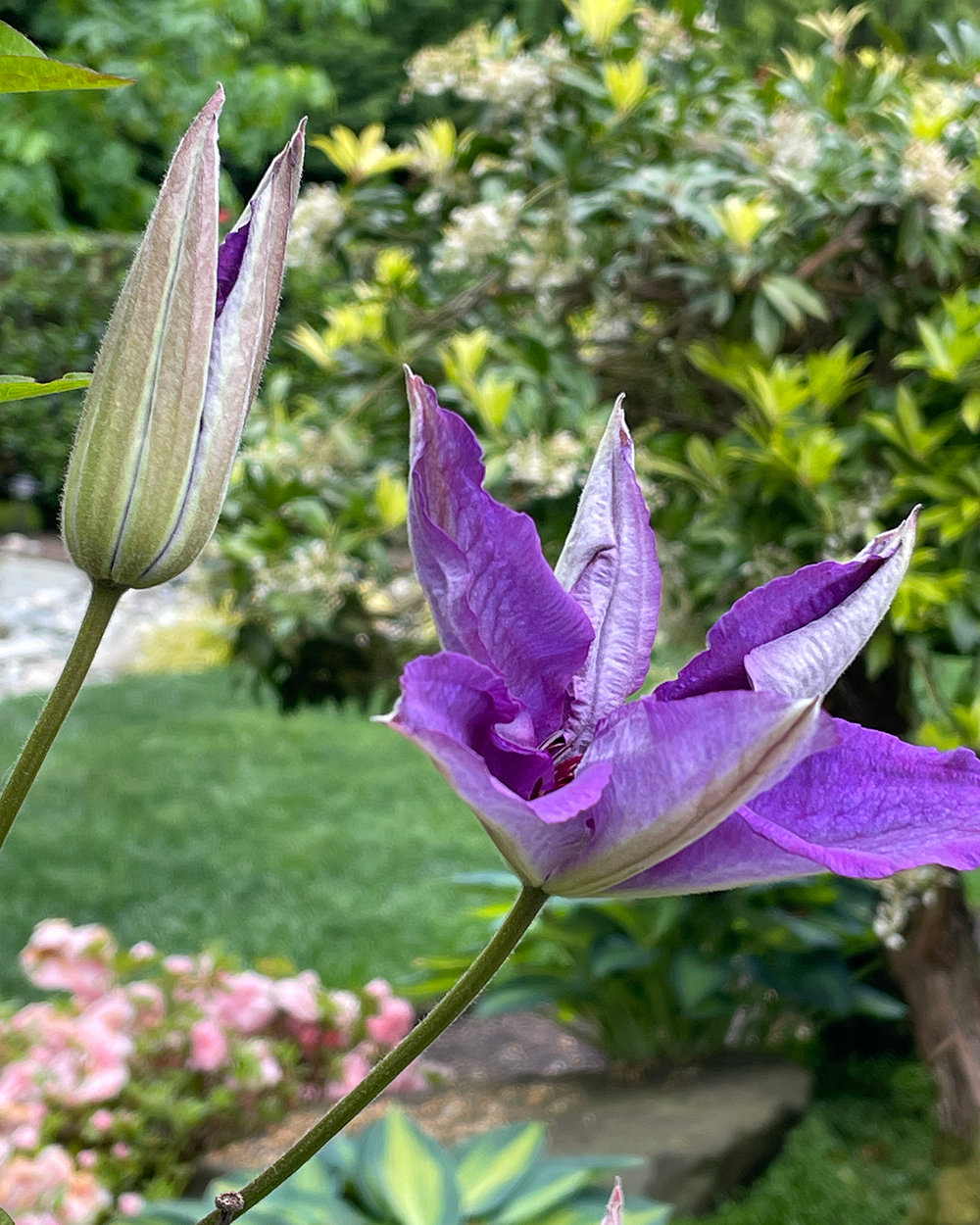 Lila’s ‘The President’ clematis is still coming into its own, but already producing a handful of outstanding blooms. And in the background, you can see that green and purple aren’t really the only colors to put on a show in her garden.
Lila’s ‘The President’ clematis is still coming into its own, but already producing a handful of outstanding blooms. And in the background, you can see that green and purple aren’t really the only colors to put on a show in her garden.
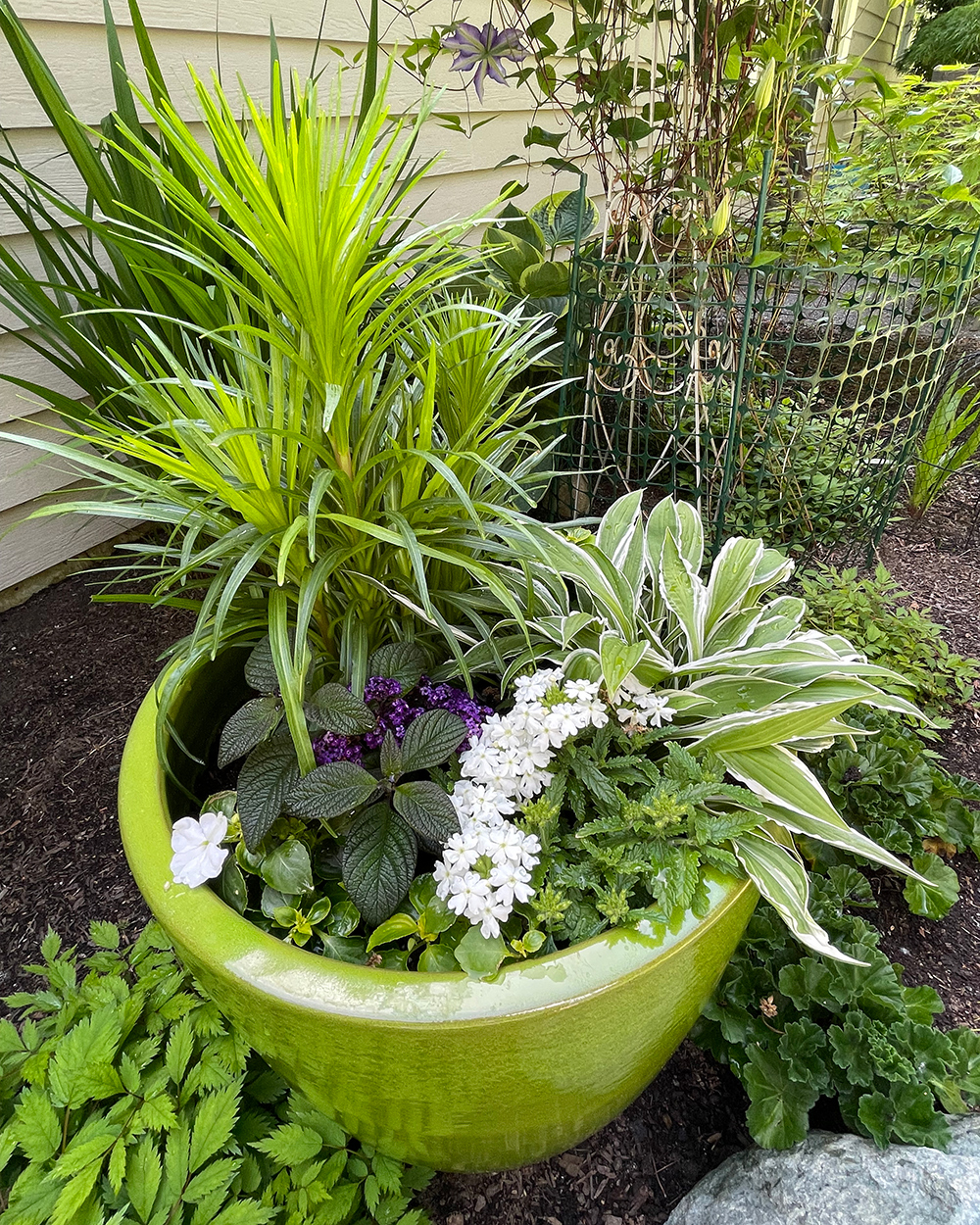 This year: white geraniums, purple liatris with purple heliotrope in the new lime-green pots.
This year: white geraniums, purple liatris with purple heliotrope in the new lime-green pots.
Thank you so much for another fabulous selection of photos from your garden, Lila! Your sea of green is far from boring with the variety of plants you pair together, and the pockets of purple are like cherries on top of your lush designs.
What colors reign supreme in your spring garden? Is there a color palette you prioritize every year, or does your landscape flourish in green like Lila’s? Let us know in the comments, or consider sharing photos of your spring garden with the blog. Follow the directions below to submit photos via email, or send me a DM on Instagram: @agirlherdogandtheroad.
We want to see YOUR garden!
Have photos to share? We’d love to see your garden, a particular collection of plants you love, or a wonderful garden you had the chance to visit!
To submit, send 5–10 photos to [email protected] along with some information about the plants in the pictures and where you took the photos. We’d love to hear where you are located, how long you’ve been gardening, successes you are proud of, failures you learned from, hopes for the future, favorite plants, or funny stories from your garden.
Have a mobile phone? Tag your photos on Facebook, Instagram or Twitter with #FineGardening!
Do you receive the GPOD by email yet? Sign up here
Fine Gardening Recommended Products
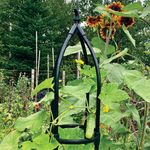
Lee Valley Garden Obelisks
Fine Gardening receives a commission for items purchased through links on this site, including Amazon Associates and other affiliate advertising programs.
Sturdy yet lightweight, these obelisks provide ample support for climbing plants while being easy to install and move. The medium obelisk stands 68 1/2″ high overall with a diameter of about 9 1/2″, compact enough for smaller containers indoors or out. The large size stands 86 1/2″ high with a diameter of 15 3/4″, ideal for larger outdoor spaces and containers.
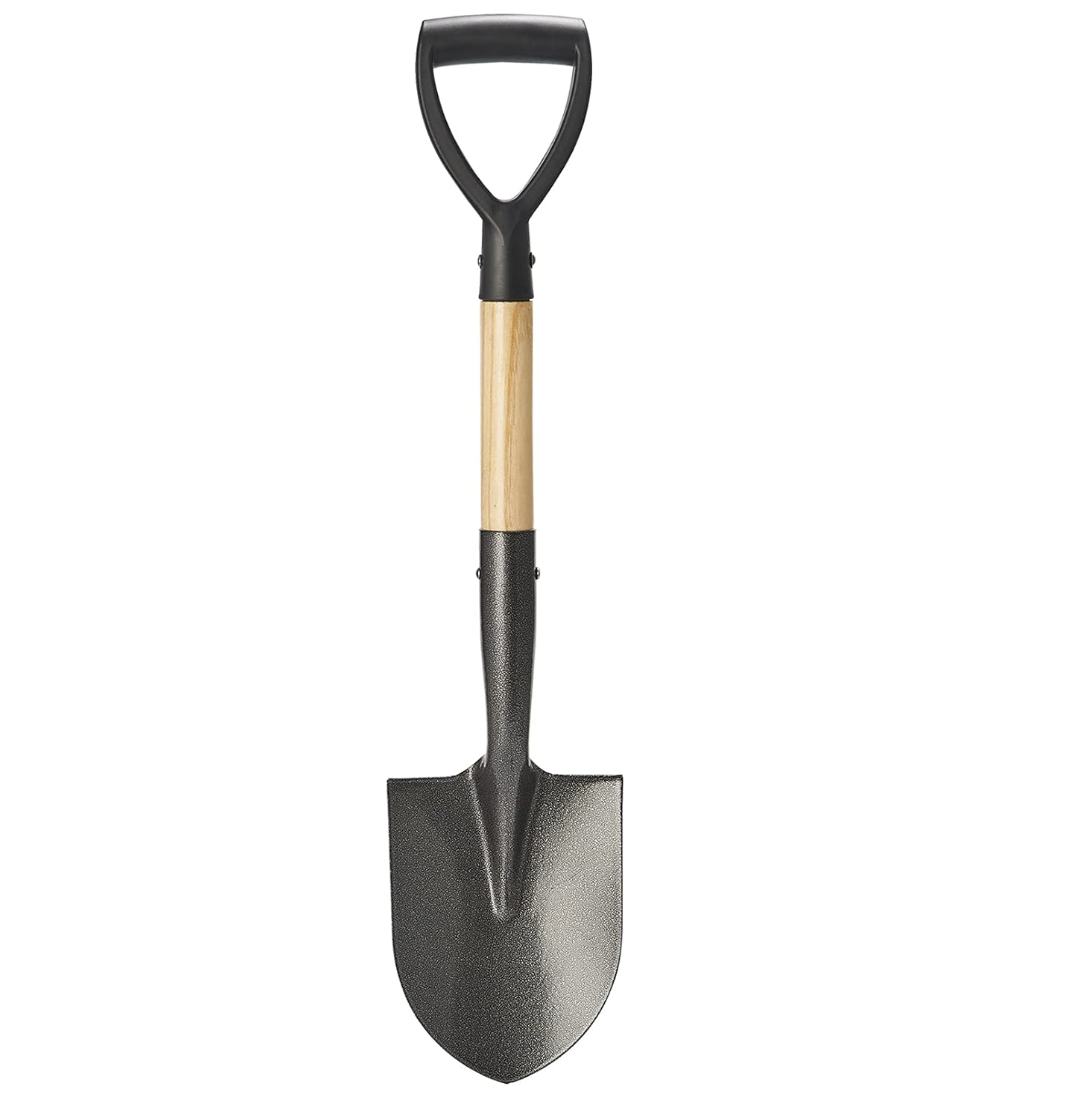
Corona® Multi-Purpose Metal Mini Garden Shovel
Fine Gardening receives a commission for items purchased through links on this site, including Amazon Associates and other affiliate advertising programs.
Longer Service Life: The blade of this round small shovel is made of carbon steel, which can effectively improve the hardness by high temperature quenching, and the surface has anti-rust coating to avoid rusting. In the process of use when encountering hard objects will not bend and deformation.
Sturdy Structure: The small garden shovel with D-handle, ergonomically designed grip can increase the grip of the hand when using, the handle is made of strong fiberglass, will not bend and break under heavy pressure. Quick Digging: Well-made digging shovel has a sharp blade, and the round shovel head is designed to easily penetrate the soil and cut quickly while digging to enhance your work efficiency.
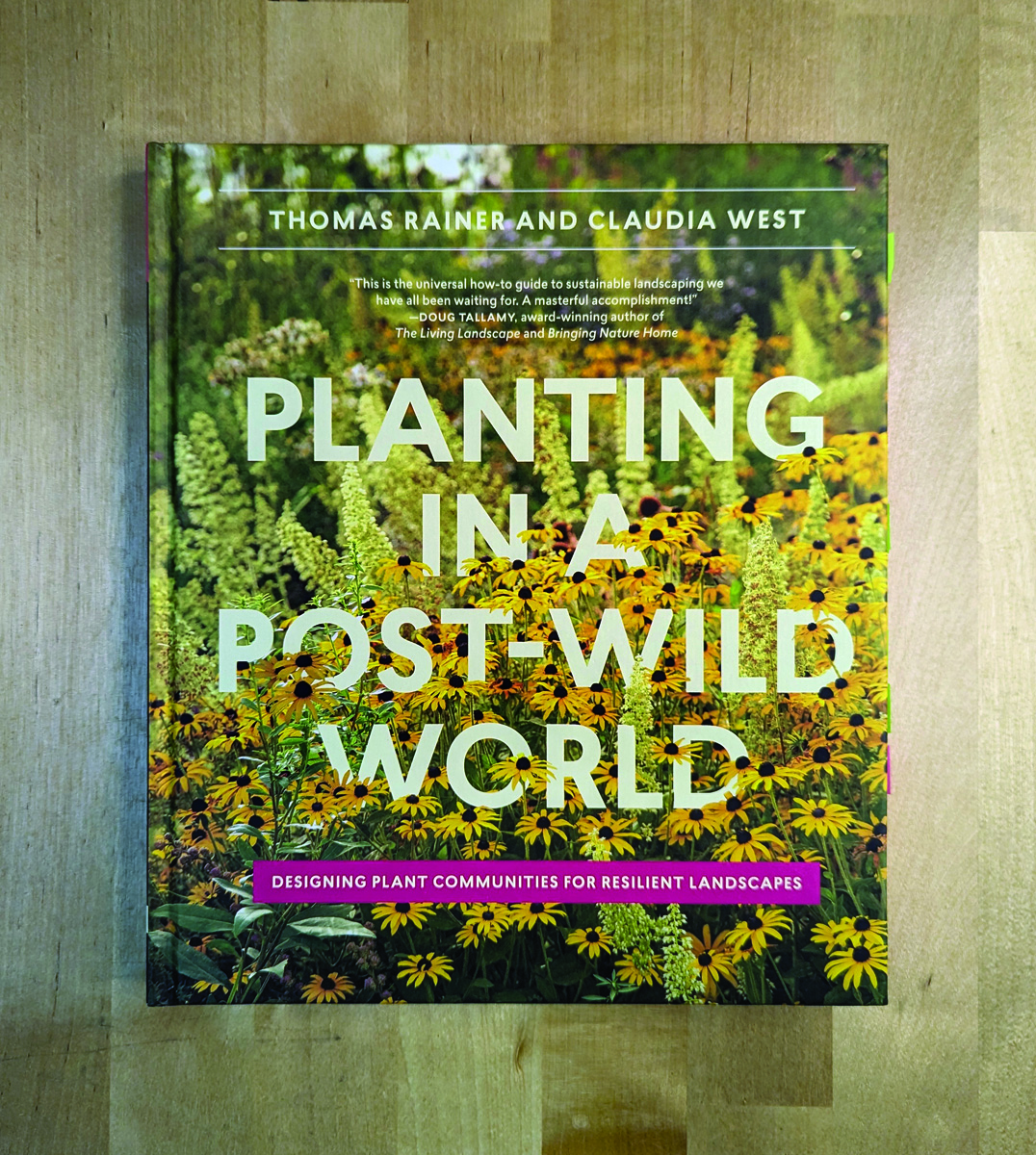
Planting in a Post-Wild World: Designing Plant Communities for Resilient Landscapes
Fine Gardening receives a commission for items purchased through links on this site, including Amazon Associates and other affiliate advertising programs.
Featuring gorgeous photography and advice for landscapers, Planting in a Post-Wild World by Thomas Rainer and Claudia West is dedicated to the idea of a new nature—a hybrid of both the wild and the cultivated—that can nourish in our cities and suburbs.

